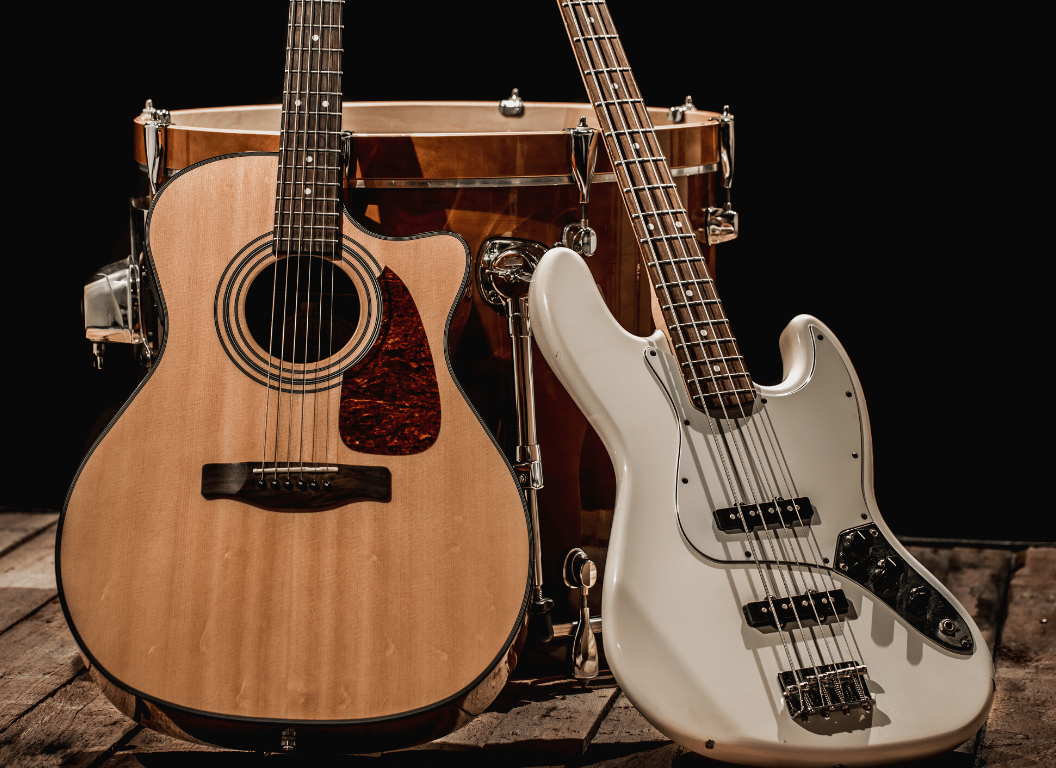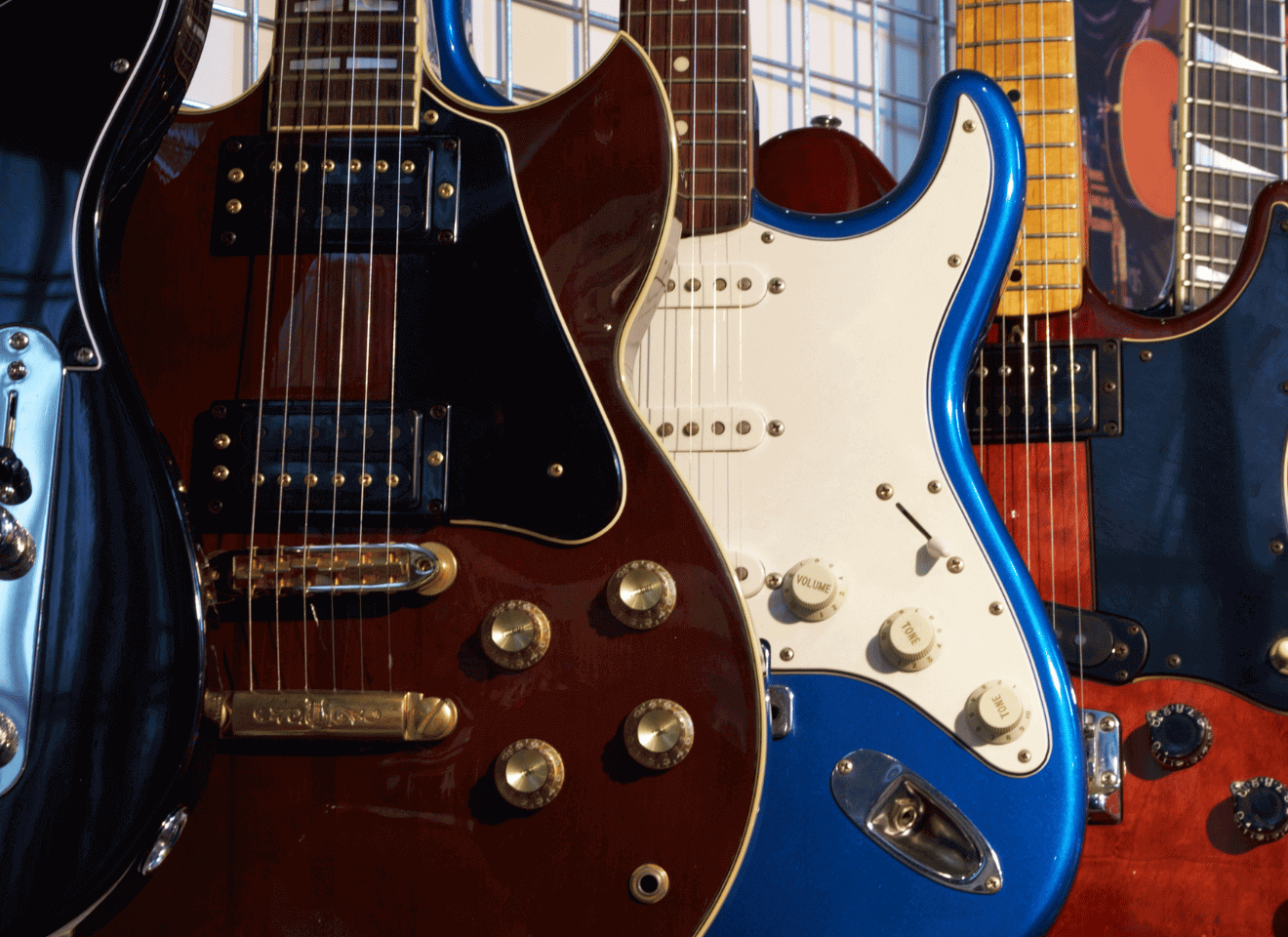Exploring the vast landscape of musical instrument categories inevitably leads to engaging debates around classification.
One such debate centers around the guitar and its placement in the realm of percussion instruments.
Traditional classifications typically list the guitar as a string instrument, given it involves the plucking or strumming of strings.
However, an entirely different perspective emerges when one considers the role and function it can perform in a musical ensemble.
Before delving into this, it is essential to understand the characteristics of percussion instruments.
This understanding creates a base for further critical analysis and comprehensive reflection.
Table of Contents
- Is A Guitar A Percussion Instrument?
- Understanding the Basics: What is a Percussion Instrument?
- A Brief Overview: What is a String Instrument?
- Classifying the Guitar: String, Percussion, or Both?
- The Unique Case of the Flamenco Guitar
- Why is a Guitar Primarily Considered a String Instrument?
- How does Striking or Strumming on a Guitar Impact Sound?
- What Happens if a Guitar is Played as a Percussion Instrument?
- What Role Does a Guitar Play in a Musical Ensemble?
- Comparing Guitar with Classical Percussion Instruments
- The Bottom Line
Is A Guitar A Percussion Instrument?
No, a guitar is not classified as a percussion instrument. It is categorized under string instruments because sound is primarily produced by plucking or strumming its strings. Percussion instruments, on the other hand, generate sound through being struck, shaken, or scraped.
Delving deeper into the topic, understanding the categorizations of musical instruments can enhance one’s appreciation for music and its various forms.
Distinguishing between string and percussion instruments is merely scratching the surface.
As we further explore this subject, invaluable insights about the unique characteristics, histories, and roles of different types of instruments in numerous musical genres will be uncovered.
This knowledge not only enriches your musical experience but also broadens your perspective On The fascinating world of sound and rhythm.
So, let’s embark on this fascinating journey and uncover the many wonders and intricacies of musical instruments.
Understanding the Basics: What is a Percussion Instrument?
Percussion instruments can be defined as musical instruments that produce sound primarily through being struck, shaken, or scraped by a beater, or by striking against another similar instrument.
They are often termed as instruments of rhythm, mainly responsible for the tempo and beat in a musical composition.
The category of percussion instruments is vast, and it encompasses a range of items, from familiar ones like drums and cymbals to more unique instruments such as marimbas and xylophones.
The Mechanics of Producing Sound
The sound production in a percussion instrument takes place when kinetic energy, exerted by hands or another instrument, causes the instrument to vibrate.
These vibrations created are unique to each type of percussion instrument and they correspond to the structure and material of the instrument.
Hence, each type of percussive instrument produces a distinct sound or note, resulting in the wide array of tones that can be achieved with these instruments.
The vibrations produced when striking a percussive instrument generate unique sound patterns.
It is this diversity in sound and rhythm creation that makes percussion instruments an integral part of almost every form of music.
They aid in creating the foundation upon which other instruments can add melody and harmony.
The Role of Percussion Instruments
In an ensemble, percussion instruments mainly define the rhythm and add texture to the sound produced.
They have the ability to keep the beat steady, add accents where required, and provide a variety of sound effects that complement other instruments.
Moreover, they can be used to highlight dramatic moments in the music or contribute to the overall mood and tone of the performance.
Also, in some musical genres, percussion instruments are used for their solo potential or for their improvisation abilities.
Percussion instruments highlight dramatic moments in a concert and contribute to the overall mood and tone of a performance.
This versatility of application makes percussion instruments a crucial part of a musical composition, with professionals often having to master a variety of these to perform efficiently in different genres and styles.
The Variety of Percussion Instruments
The world of percussion instruments is diverse and includes a number of different categories.
The most common distinction is between idiophones, which produce sound primarily from the instrument’s vibrating body, and membranophones, where a stretched membrane produces the sound.
Besides these, there are various percussion instruments classified according to their tuning ability, method of play, and cultural origins, leading to a rich and varied landscape.
The vast range of percussion instruments available, each with its unique sound properties, provides musicians with endless possibilities for creating music.
Immersing yourself in this video will enhance your understanding of how percussion techniques can be implemented On The guitar.
It will also offer insight into generating a variety of rhythmic patterns and sound effects using these techniques.
Isn’t it fascinating how the world of rhythm and beats can broaden your musical horizons?
A Brief Overview: What is a String Instrument?
A string instrument, as its name suggests, is an instrument that creates sound from vibrating strings.
These strings can be plucked, bowed, or struck, each method producing a unique and diverse range of sounds.
Different types of String Instruments
String instruments come in a wide variety of shapes and sizes, from small ukuleles and mandolins to large cellos and double basses.
Despite their differences in size, most stringed instruments share a basic structure: a body, a neck, and tuning pegs that adjust the pitch of the strings.
One end of each string is usually fixed to the body of the instrument, while the other end is attached to a tuning peg.
The strings are set into motion by either plucking, striking or drawing a bow across them.
> One end of each string is usually fixed to the body of the instrument, while the other end is attached to a tuning peg.
The sound produced by a string instrument can be amplified and varied by the properties of the instrument’s body.
The body acts as a resonator, trapping the vibrations of the strings and amplifying them to create the sound we recognize as music.
The Role of Resonance in String Instruments
Resonance is a critical phenomenon in the physics of string instruments.
It works when the body of the instrument vibrates at the same natural frequency as the strings, amplifying the resulting sound.
This amplified sound is then projected out of the instrument, usually through a sound hole or f-holes, in the case of instruments like violins and cellos.
The size, shape, and materials used in the body of the string instrument all contribute to the quality and character of the sound it produces.
> The size, shape, and materials used in the body of the string instrument all contribute to the quality and character of the sound it produces.
The tone and volume of the sound can also be adjusted by modifying the placement, pressure, and speed of the bow or by the technique of the finger plucking the strings.
The ability to manipulate these factors is one reason why string instruments are capable of producing such a wide range of pitches and musical expressions.
In conclusion, understanding the basics of string instruments is crucial in comprehending the function and classification of particular instruments such as the guitar.
This knowledge is the foundation that supports further exploration into the unique aspects of various string instruments and their respective roles in creating music.
Classifying the Guitar: String, Percussion, or Both?
The classification of a guitar has long been a topic of debate among music theorists and enthusiasts alike.
At its core, the guitar is regarded as a stringed instrument due to the fundamental method of producing sound.
Attempting to classify it otherwise might, at first glance, appear to stray from the norm or traditional understanding.
Exploring the characteristics of percussion and stringed instruments becomes critical in understanding the place of the guitar within these categories.
A percussion instrument creates sound when it is struck, scraped, or shaken, while a stringed instrument produces sound through the vibration of its strings.
The Hybrid Nature of the Guitar
The guitar, like many other instruments, also possesses a hybridized nature.
Undeniably, the guitar involves the vibration of strings to create sound, aligning it with the core principle of stringed instruments.
At the same time, the player’s interaction with the strings often involves striking or plucking, borrowing elements of the percussion category.
One could not deny that the sound created by a guitar is down to the vibration of its strings after being plucked or struck, and the strings’ tension and the guitarist’s handling directly affects the sound’s pitch and tone.
This suggests that guitars, while fundamentally stringed instruments, carry significant percussive elements in their sound production.
The guitar, like many other instruments, also possesses a hybridized nature.
Supporting this statement, a few examples could be how the tapping technique in guitar playing exemplifies percussive qualities, the strumming pattern can resemble rhythm patterns commonly found in percussion playing, and the mute technique can reduce the guitar sound into a more percussive tone.
The Flamenco Guitar as Percussion
Delving deeper into guitar’s styles also supports this argument, particularly the case of flamenco guitar.
In flamenco style, the guitarist not only plays the strings but also taps On The guitar’s body, creating a rhythmic pattern – a mark of a percussion instrument.
This online video resource will allow you to observe flamenco guitar techniques performed by a professional guitarist.
The video could provide a deeper understanding of the significant skill and techniques required to utilize and transition between the guitar’s dual nature as a string and percussion instrument.
The percussive nature of the flamenco style of guitar playing is a clear example of how a guitar’s classification isn’t simple or neatly fit into one category, showcasing the complex dimensions of music and instrument classification.
Ultimately, to answer the question raised at the start, the guitar can be considered both a string and percussion instrument, dependent On The style and techniques of play implemented by the musician.
This hybrid quality of the guitar adds to its versatility and appeal, making it one of the most beloved and widely utilized instruments in the world today.
The Unique Case of the Flamenco Guitar
The flamenco guitar is a uniquely rich instrument with a history rooted in the vibrant culture of Spain’s Andalusian region.
Its distinctive sound differs from other guitar types, making its classification a topic of interest.
Traditional Flamenco Guitar Playing
The traditional way of playing the flamenco guitar involves percussive techniques like tapping On The guitar’s body to accompany the strumming of its strings.
This introduces a layer of complexity in instrument categorization as the guitar transcends from being merely a string instrument to having percussive qualities.
The flamenco guitar’s unique playing style produces a powerful, rhythmic sound that emulates the beat of a drum.
As such, the flamenco guitar can easily be perceived as a percussion instrument, with its rhythmic beats and taps.
By classifying the guitar solely On The basis of how it’s traditionally played, it would be erroneously limited to a single category, overlooking its wide array of sounds and techniques.
Sound Production in Flamenco Guitar
The sound in the flamenco guitar primarily originates from the vibration of the strings which reverberate within the wooden body.
However, the percussive sound is achieved when the guitarist taps the guitar body, accentuating the rhythm of the music.
The timbre of the guitar, whether warm or bright, is achieved by the quality of the wooden material and the techniques employed by the musician.
This dual nature shifts the guitar from a mere string instrument to something more complex and diverse.
The percussive element of the flamenco guitar does not outweigh its function as a string instrument
The dual nature of the guitar as both a string and percussive instrument plays a significant role in defining its unique sound but fundamentally, the music produced by the guitar is determined more by the strings than by the percussive sounds.
The percussive elements add an extra layer of rhythmic complexity, but at the end of the day, the melody still comes from the strumming and plucking of strings.
Diversity of Musical Techniques
The flamenco guitar incorporates a wealth of techniques, including finger picking, strumming, tapping, and hitting the body of the guitar.
In this respect, it mirrors certain elements of the cajon and Spanish percussive dance shoes.
These diverse techniques help to create a rich texture of sound, adding to the uniqueness of the flamenco guitar.
However, regardless of the percussive techniques used, the fundamental structure and the operation of the guitar remain the same.
The diversity of musical techniques On The flamenco guitar further underscores its simultaneous function as both a string and percussion instrument.
Despite the percussive techniques, it’s important to remember that the string component of the guitar plays a predominant role in the music creation.
Overall, the percussive elements add a unique flavor to the flamenco guitar, but its primary function as a string instrument is paramount.
Why is a Guitar Primarily Considered a String Instrument?
The guitar is primarily considered a string instrument due to the machanism in which sound is produced.
The creation of sound involves the vibration of strings, which is amplified by a hollow wooden box to project the tones to the audience.
The Science of String Vibration
The vibration of a guitar string has a natural frequency, determined by its mass, length, and tension.
When struck or plucked, the string oscillates at this frequency, creating a unique pitch.
The vibration is transferred to the body of the guitar, causing the air inside the guitar’s body to also vibrate.
This vibration creates an amplified version of the string’s sound which is then projected out of the guitar’s soundhole.
The materials used in the construction also significantly affect the sound produced, adding to the complexity of the instrument.
The vibration of a guitar string has a natural frequency, determined by its mass, length, and tension.
This is the reason why every guitar may sound different, even if they are of the same model or brand.
The individual characteristics of each piece of wood, and its assembly, contribute to the unique sounds produced by each guitar.
The Role of Plucking and Strumming
When a guitar string is plucked or strummed, the initial attack of the string and the sustain that follows, creates the typical sound associated with guitars.
In addition, by shortening or lengthening the strings via the fretboard, a guitarist can create a variety of pitches.
It is this rich, dynamic and melodious sound that has made the guitar a beloved instrument in many music genres.
When a guitar string is plucked or strummed, the initial attack of the string and the sustain that follows, creates the typical sound associated with guitars.
This manipulation of sound explains why the instrument can express a wide range of emotions and musical intents.
Whether in the hands of a flamenco artist, a bluesman, a rock star, or a folk singer, the guitar is capable of expressing a wide range of emotions and musical intents.
By watching the video, you will see a vivid demonstration of these facts and more.
You will certainly gain a deeper understanding of the inner workings of the guitar and why it is primarily defined as a string instrument.
How does Striking or Strumming on a Guitar Impact Sound?
When it comes to guitars, the way the strings are struck or strummed has an immense impact On The sounds produced.
Those new to the world of guitars might find it startling because their understanding of a musical instrument revolves around the idea of creating melodies using different notes.
However, it becomes a real game-changer with guitars.
It’s noteworthy to comprehend that the dynamics of strumming and striking can indeed change the character of a guitar’s sound.
The variation in the striking pressure, angle of the pick and speed significantly influences the quality of the sound.
Musicians often use this to their advantage to bring out the variety in their music.
It’s noteworthy to comprehend that the dynamics of strumming and striking can indeed change the character of a guitar’s sound.
This dynamic variation offered by guitars makes them a versatile tool, giving a vast palette of sounds to choose from.
This is also one of the reasons why guitars hold an integral place in various genres of music globally.
Musicians often apply their creativity and ingenuity in the way they strum or strike the guitar strings, thereby adding a unique touch to their music.
The Impact of Strumming Direction
The direction of the strum matters a lot as well.
A downstroke, where the strum is made in a downward direction, gives a heavy and powerful sound, while an upstroke, the upward strum, provides a lighter and mellower tone.
This gives the artists a large spectrum of sounds to play with.
Often in fast-paced genre, the artist would alternate between downstroke and upstroke to maintain the pace of the music while adding a rhythmic variation.
This art of strumming direction has a significant influence over the sound character, offering diversity to the player and thus becoming a vital essence of guitar playing.
Often in fast-paced genre, the artist would alternate between downstroke and upstroke to maintain the pace of the music while adding a rhythmic variation.
Professional musicians and guitarists spend countless hours mastering the skill of varying their strumming directions to enhance the depth of their music.
They strategically devise the mix of these strumming directions in their pieces to build up the desired mood and feel.
Striking as a Game Changer
Besides strumming, striking the strings or the guitar body provides yet another dimension to the sound produced by a guitar.
Striking a string more harshly will produce a louder and sharp sound, while a softer strike gives a soothing and silent tone.
Striking is not only limited to the strings.
In fact, various percussive techniques involve striking different parts of the guitar body to produce interesting rhythmic patterns.
On acoustic guitars, these percussive techniques can bring about an effect similar to a drum kit, adding to the percussiveness of the guitar.
On acoustic guitars, these percussive techniques can bring about an effect similar to a drum kit, adding to the percussiveness of the guitar.
Flamenco players often use these techniques to create a rhythmic undertone in their performance.
It’s a testament to how striking techniques can revolutionize the overall playing experience and enhance the versatility of guitars.
From creating a melody line and providing an accompanying rhythm to producing a drum kit effect, the guitar can do it all when played with the right techniques.
What Happens if a Guitar is Played as a Percussion Instrument?
The distinctive nature of the guitar, being both string and potentially percussion, allows for a wide range of expressive possibilities.
When a guitar is played as a percussion instrument, the ways in which it produces sound profoundly changes.
Guitar as a Percussion Instrument
Normally, a guitar produces sound through the vibration of strings.
However, when played as a percussion instrument, the guitar body itself becomes the primary source of sound.
The strings, the wood, and the hollowness of the body all contribute to a unique percussion sound when hit with the hand or a plectrum.
Players tap, slap, and drum On The instrument’s body and strings to create rhythmic patterns and percussive melodies.
“Players tap, slap, and drum On The instrument’s body and strings to create rhythmic patterns and percussive melodies.”
This technique highlights a different side of the instrument’s potential, creating a palette of sounds beyond the traditional strumming or picking.
The Impact on Sound
The quasi-percussive playing often leads to a more resonant and vibrant tone, and other characteristics typical of stringed instruments may recede into the background.
Using the guitar as a percussion instrument changes both its acoustic properties and the manner in which it participates in the sonic texture of a song or a performance.
Experimenting with percussive guitar technique potentially transforms the instrument’s role from strictly melodic or harmonic to rhythmically pertinent.
“Experimenting with percussive guitar technique potentially transforms the instrument’s role from strictly melodic or harmonic to rhythmically pertinent.”
The tonal shift that accompanies this technique allows musicians to approach the guitar from a new perspective, opening up a wealth of rhythmic possibilities.
This video will provide a visual reference for you to understand the points mentioned above.
The guitarist demonstrates how tapping, slapping, and drumming On The body of the guitar changes the sound significantly.
Considerations and Limitations
When employing percussive techniques On The guitar, restraint and balance are crucial.
There is a risk of overuse which can make the music seem less focused and possibly lead to a muddled sound.
Careful and judicial use of these techniques can enhance the aesthetic value of the music, while excessive use could potentially distract.
The musician must maintain a balance between the traditional and percussive techniques to deliver a well-rounded performance.
“The musician must maintain a balance between the traditional and percussive techniques to deliver a well-rounded performance.”
A guitar that’s played like a percussion instrument may blur the lines between the definitive roles of string and percussive instruments in an ensemble.
Hence, careful thought must be given to blending these techniques in a way that complements the overall musical structure.
What Role Does a Guitar Play in a Musical Ensemble?
Role of Guitar as a Melodic Driving Force
Primarily, a guitar adds immense depth to the music with its unique ability to produce varied sounds, and often acts as one of the melodic driving forces in a musical ensemble.
An acoustic guitar using standard tuning can produce sounds spanning three octaves, allowing it to play key melodies or harmonise with other instruments.
The guitar can skillfully blend with other sounds to create an overall textured feel.
Moreover, because of its versatility, many styles of music embrace the guitar, from rock and pop to jazz and classical, making it an indispensable part of many ensembles.
The guitar can skillfully blend with other sounds to create an overall textured feel.
This blending ability of the guitar forms an essential characteristic of how a guitar is perceived in a band or orchestra, seamlessly integrating with other instruments and voice.
It provides the backbone to the music and supports the melodic line of a composition.
Percussive Element of Guitar Playing
Guitars, particularly in modern styles of music, often play an important role as percussive instruments.
Percussion in music refers to striking instruments to create rhythm or dynamics and guitars, especially in genres like flamenco or fingerstyle, often use percussive techniques to achieve rhythmic patterns.
By tapping, slapping, or hitting different parts of the guitar body, a guitarist can achieve a variety of percussive sounds that can imitate drums or other percussion instruments.
While not a traditional role of the guitar, this percussive element can add a distinct flavour to the ensemble’s overall sound.
Percussion in music refers to striking instruments to create rhythm or dynamics and guitars, especially in genres like flamenco or fingerstyle, often use percussive techniques to achieve rhythmic patterns.
Sides, top and back of the guitar each have unique resonance and tonal characteristics which produces a varied percussive soundscape.
Therefore, in a band, where conventional drums aren’t present or a solo acoustic performance, a guitar might be played in a percussive manner to bring rhythmic completeness.
Versatility of Guitars in Music
The role of a guitar in a musical ensemble can change quite dramatically based On The genre of music being played, the ensemble’s composition, and the particular piece at hand.
With the guitar, the artist has a tool at their disposal that can act as a standalone instrument, accompany other musical instruments, or even mimic a mini orchestra.
This flexibility characterises the charm of the instrument and its important role in music ensembles across the globe.
The beauty of guitar playing lies in the balance of melody, harmony, and rhythm, it brings to a musical composition, all while operating within the constraints and liberties of the ensemble it’s a part of.
The beauty of guitar playing lies in the balance of melody, harmony, and rhythm, it brings to a musical composition, all while operating within the constraints and liberties of the ensemble it’s a part of.
This versatility of guitars only underscores their importance in various musicscapes, making them an adaptable and integral part of any music ensemble.
From setting the rhythm to providing melodic directions to songs, the role of the guitar is critical for any musical compilation.
Comparing Guitar with Classical Percussion Instruments
When it comes to musical instruments, two categories that significantly stand out are string and percussion instruments.
Even though they both play essential roles in creating music, they do so using notably different methods and techniques.
A guitar, for instance, falls under the classification of string instruments.
It uses vibrations of its strings to produce sound, and it is primarily played by strumming or plucking the strings.
Classical Percussion Instruments
On the other hand, classical percussion instruments include drums, xylophones, gongs, and cymbals, among others.
These instruments produce sound when struck, shaken, or scraped.
Unlike the guitar which uses tension in strings to create sound, percussion instruments depend On The vibration of their entire body or a specific part of it to produce sound.
The basic principle of sound production in percussion instruments largely varies from that of the guitar.
This difference is due to the varying materials and structures used in constructing these instruments, as well as the techniques involved in playing them.
Comparing Sounds
In terms of sound quality, the guitar, being a string instrument, generally produces melodic and harmonic sounds.
It has the ability to simultaneously create multiple notes, enabling the formation of chords.
Percussion instruments, nevertheless, are typically renowned for their rhythmic contributions.
Although some of them are capable of generating pitches (for example, the xylophone and timpani), their primary function often lies in setting the rhythm and providing accents in the music.
The guitar and percussion instruments, in their distinctive ways, significantly contribute to the orchestration and arrangement of a piece of music.
Both of them can complement each other perfectly, creating an interplay of melodic, harmonic, and rhythmic elements that bring music to life.
Technique and Interaction
Another difference lies in how musicians interact with these instruments.
Playing the guitar requires fingers or a plectrum to strum or pluck the strings.
In contrast, playing percussion instruments often involves the use of sticks, mallets, brushes, or sometimes the hands, to strike the instrument.
Feel free to check out the embedded video above.
You might gain insight into how different techniques are employed when playing a guitar, specifically flamenco styles.
Understanding the differences between the guitar and classical percussion instruments can help appreciate the wide range of techniques, sounds, and roles these instruments feature in music creation.
The Bottom Line
After a detailed examination, it is evident that a guitar, even with its unique percussive capability, is primarily a string instrument.
Its design, sound production, and the central role it plays in a musical ensemble, all point towards its classification as a string instrument.
It’s true that in specific styles, particularly flamenco, and with certain techniques the guitar can fulfill a percussive function.
However, these remain the exceptions rather than the norm and do not shift its categorization away from being a string instrument.
While some elements of percussion do exist, when contrasted with classical percussion instruments, the guitar’s differences are stark and undeniable.
Thus, while its versatility is one of its strengths, it is the guitar’s inherent string dynamics that define its character and classification in music.

An avid storyteller and music lover that devotes all his free time to mastering the art of playing guitar. I’ve played acoustic for 6 years, and recently started playing electric guitars. Currently playing an Epiphone SG Special!




